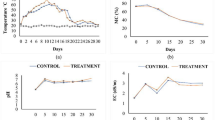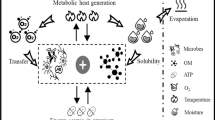Abstract
Because temperature is a limited factor in compost process, we attempted to isolate and screen efficient themophilic and psychrophilic strains from composts and soils adapting to high and low temperature, respectively. Firstly, two cellulose-effectively-decomposing thermophilic bacteria, HNS39 and HNC41, were screened from 13 thermophilic compost samples and one soil sample from tropical rain forest. By addition of microbial agents with single HNS39, HNC41, or their mixture (1:1 v/v), the progress of composing was more effectively improved with HNS39. According to 16S rDNA gene sequencing and its growth characteristics, HNS39 was identified as Geobacillus sp. Meanwhile, the psychrotrophs strains of B6-38, B10-40, B10-44 isolated, could rapidly reproduce and effectively degrade organic compounds with highest enzyme activity in low temperature from 10 samples collected from sewage sludge, poultry manure and paddy soil. It was indicated that cold-adapted bacteria had a better effect on the raise of composting temperature, especially B6-38 with the highest protease activity of 46.08 U/ml. It grew fast and had good ability of enzyme production and strong organic degradation capabilities at 15 °C. By identification, Strain B6-38 was associated with Aeromonasa sp. Therefore, the research was fully shown that the isolated thermophilic and psychrophilic microorganisms had high potential of application in the composting under high and low temperature.






Similar content being viewed by others
References
Lu, J.B., Zhu, L., Hu, G.L., Wu, J.G.: Integrating animal manure-based bioenergy production with invasive species control: a case study at Tongren Pig Farm in China. Biomass. Bioenerg. 34, 821–827 (2010)
Ren, N.Q., Wang, A.J., Cao, G.L., Xu, J.F., Gao, L.F.: Bioconversion of lignocellulosic biomass to hydrogen: potential and challenges. Biotechnol. Adv. 27, 1051–1060 (2009)
Ichida, J.M., Krizova, L., LeFevre, C.A., Keener, H.M., Elwell, D.L., Burtt, E.H.: Bacterial inoculum enhances keratin degradation and inoculum on the degradability of poly-caprolactone during composting. J. Microbiol. Meth. 47, 199–208 (2001)
Gaind, S., Pandey, A.K., Lata, N.: Biodegradation study of crop residues as affected by exogenous inorganic nitrogen and fungal inoculants. J. Basic Microbiol. 4, 301–311 (2005)
Kato, K., Miura, N.: Effect of matured compost as a bulking and inoculating agent on the microbial community and maturity of cattle manure compost. Bioresour. Technol. 99, 3372–3380 (2008)
Wang, H.Y., Fan, B.Q., Hu, Q.X., Yin, Z.W.: Effect of inoculation with Penicillium expansum on the microbial community and maturity of compost. Bioresourc. Technol. 102, 11189–11193 (2011)
Vargas-García, M.C., Suárez-Estrella, F.F., López, M.J., Moreno, J.: Influence of microbial inoculation and co-composting material on the evolution of humic-like substances during composting of horticultural wastes. Process Biochem. 41, 1438–1443 (2006)
Ahlawat, O.P., Vijay, B.: Potential of thermophilic bacteria as microbial inoculant for commercial scale white button mushroom (Agaricus bisporus) compost production. J. Sci. Ind. Res. 69, 948–955 (2010)
Wakase, S., Sasaki, H., Itoh, K., Otawa, K., Kitazume, O., Nonaka, J.: Investigation of the microbial community in a microbiological additive used in a manure composting process. Bioresour. Technol. 99, 2687–2693 (2008)
Zeng, G.M., Huang, H.L., Huang, D.L., Yuan, X.Z., Jiang, R.Q., Yu, M.: Effect of inoculating white-rot fungus during different phases on the compost maturity of agricultural wastes. Process Biochem. 44, 396–400 (2009)
He, H.X., Xu, F.H., Zhao, X.F., Wan, S.M.: Effects of inoculated complex microbialagent to cattle manure on compost temperature and microorganism under low temperature. J. Northeast Agr. University 38(1), 54–58 (2007)
Rastogi, G., Bhalla, A., Adhikari, A., Bischoff, K.M., Hughes, S.R., Christopher, L.P., Sani, P.K.: Characterization of thermostable cellulases produced by Bacillus and Geobacillus strains. Bioresour. Technol. 101(22), 8798–8806 (2010)
Sheridan, P., Miteva, V., Brenchley, J.: Phylogenetic analysis of 16S rDNA of anaerobic psychrophilic enrichment cultures obtained from a Greenland Glacier Ice Core. Appl. Environ. Microbiol. 69, 2153–2160 (2003)
Ghose, T.K.: Measurement of cellulase activities. Pure Appl. Chem. 59(2), 257–268 (1987)
Wang, X.F., Xu, X.S., Wu, M., Wang, G., Liu, Q.M.: Isolation and screening of cellulose-decomposing microorganisms. Biotechnol. 11(2), 27–30 (2001)
Shi, Y.C., Jiang, Y.M.: Comparision of five methods for the assaying of α-amylase activity. Microbiol. 23(6), 371–373 (1996)
Wang, X.P., Xing, S.L.: Determination of protein quantitation using the method of coomassie brilliant blue. Tianjin Chem. Ind. 23(3), 40–42 (2009)
Wilson, K.: Preparation of genomic DNA from bacteria. Curr. Protoc. Mol. Boil. 11, 241–245 (2001)
Muyzer, G., Waal, E.C.D., Uitterlinden, A.G.: Profiling of complex microbial populations by denaturing gradient gel eletrophoresis analysis of polymerase chain reaction-amplified genes coding for 16S rRNA. Appl. Environ. Microbiol. 59, 695–700 (1993)
Wang, S.N., Liu, Z., Xu, P.: Biodegradation of nicotine by a newly isolated Agrobacterium sp. strain S33. J. Appl. Microbiol. 107, 838–847 (2009)
Haruta, S., Cui, Z., Huang, Z., Li, M., Ishii, M., Igarashi, Y.: Construction of a stable microbial community with high cellulose-degradation ability. Appl. Microbiol. Biot. 59, 529–534 (2002)
Pedro, M.S., Haruta, S., Hazaka, M., Shimada, R., Yoshida, C., Hiura, K., Ishii, M., Igarashi, Y.: Denaturing gradient gel electrophoresis analysis of microbial community from field-scale composter. J. Biosci. Bioeng. 91, 159–165 (2001)
Hu, Z.H., Lane, R., Wen, Z.Y.: Composting clam processing wastes in a laboratory- and pilot-scale in-vessel system. Waste Manag. 29, 180–185 (2009)
An, C.J., Huang, G.H., Yao, Y., Sun, W., An, K.: Performance of in-vessel composting of food waste in the presence of coal ash and uric acid. J. Hazard. Mater. 203–204, 38–45 (2012)
Belyaeva, O.N., Haynes, R.J.: Chemical, microbial and physical properties of manufactured soils produced by co-composting municipal green waste with coal fly ash. Bioresour. Technol. 100, 5203–5209 (2009)
Acknowledgments
This work was financially supported by the National Science and Technology Pillar Program during the 12th Five-year Plan Period (2012BAD14B01) and Ecology Key Discipline Project of Beijing Municipal Education Commission, China (071012). Special thanks are due to the reviewers for their valuable comments on the manuscript.
Author information
Authors and Affiliations
Corresponding author
Rights and permissions
About this article
Cite this article
Wang, L., Wang, L., Wang, D. et al. Isolation and Application of Thermophilic and Psychrophilic Microorganisms in the Composting Process. Waste Biomass Valor 5, 433–440 (2014). https://doi.org/10.1007/s12649-013-9253-8
Received:
Accepted:
Published:
Issue Date:
DOI: https://doi.org/10.1007/s12649-013-9253-8




